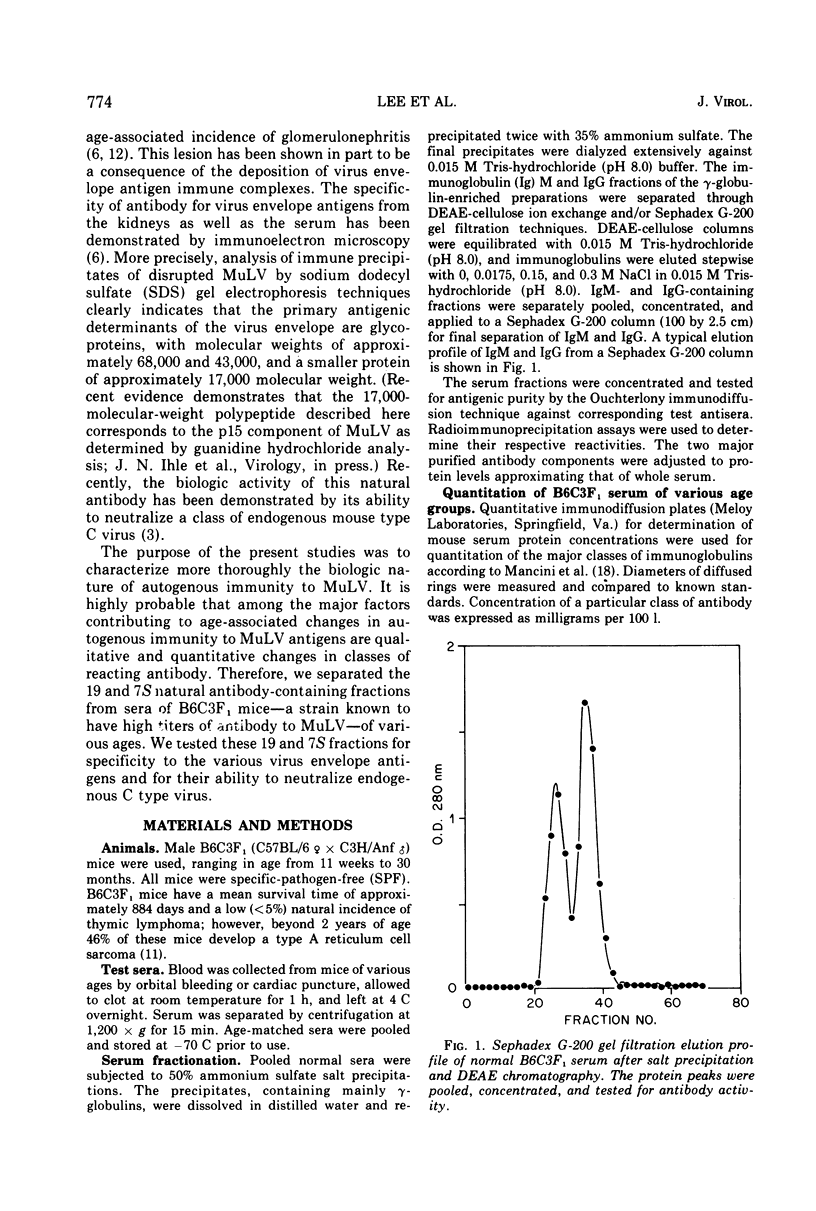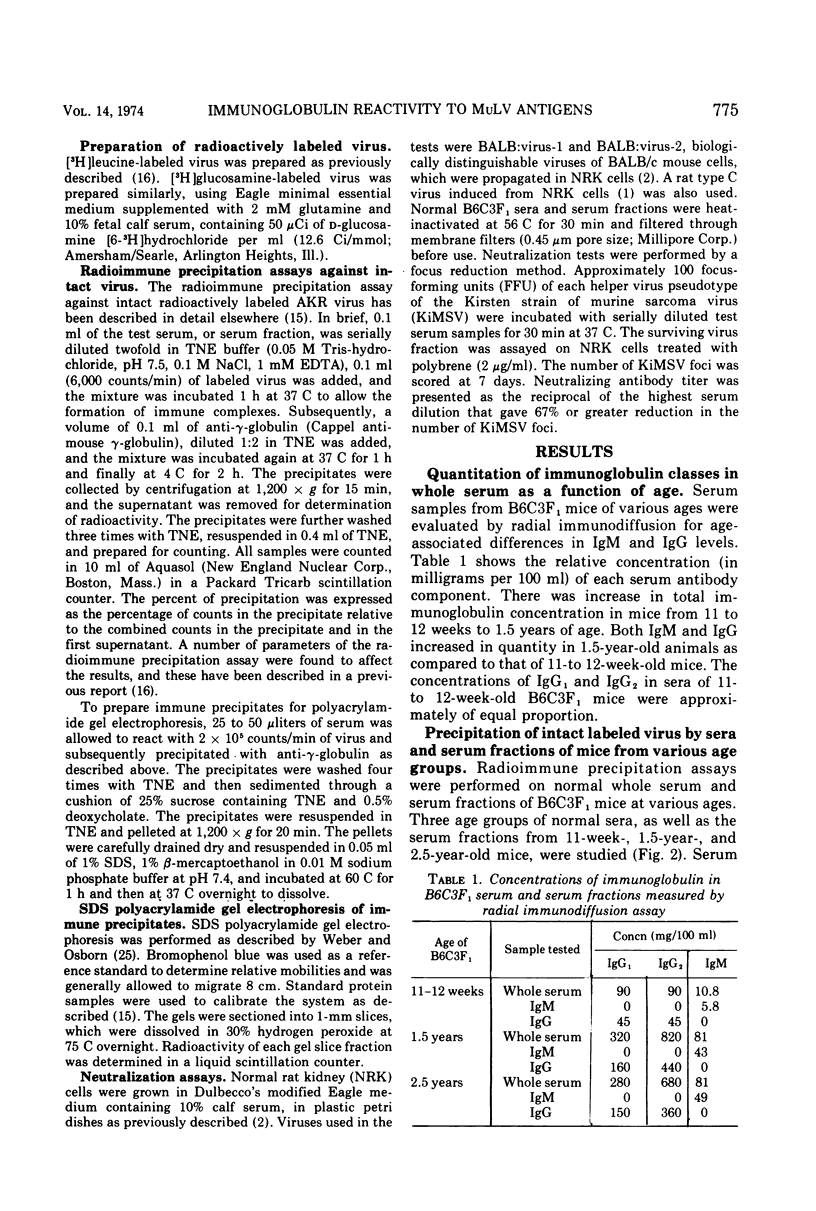Abstract
The autogenous humoral immune response of mice to their endogenous leukemia virus has been examined in terms of the reactivities of individual classes of antibody present in normal B6C3F1 serum. Whole serum and the immunoglobulin (Ig) M and IgG fractions of serum from animals of different age groups were compared by radioimmune precipitation assays and viral infectivity neutralization assays. Both IgM and IgG fractions were able to precipitate virus, although not as effectively as whole serum. Virus-specific antibody levels, as well as total antibody concentrations in whole serum, appeared to increase with age. Sodium dodecyl sulfate gel electrophoresis analysis was performed with immune precipitates obtained when whole serum or 19 or 7S fractions from animals of different age groups were reacted with disrupted virus. The 19S antibody fraction reacted with three antigenic determinants on the viral envelope. These antigens have apparent molecular weights of 17,000, 43,000, and 68,000. The last two appear to be glycoproteins and may correspond to the M2 and M1 antigens. In contrast, the 7S component reacted only with the 17,000-molecular-weight protein. Neutralization assays against BALB:virus-2, a xenotropic endogenous mouse type C virus, revealed that 19S and whole serum but not the 7S fraction possessed neutralizing activity. These findings indicate that there are differential reactivities of IgM and IgG antibodies in normal serum of B6C3F1 mice, with respect to both recognition of viral envelope antigens and neutralization of endogenous MuLV. These results are consistent with the hypothesis that the autogenous humoral immune response is a systemic host function that may be important in the regulation of endogenous type C virus expression in vivo.
Full text
PDF








Selected References
These references are in PubMed. This may not be the complete list of references from this article.
- Aaronson S. A., Stephenson J. R. Independent segregation of loci for activation of biologically distinguishable RNA C-type viruses in mouse cells. Proc Natl Acad Sci U S A. 1973 Jul;70(7):2055–2058. doi: 10.1073/pnas.70.7.2055. [DOI] [PMC free article] [PubMed] [Google Scholar]
- Aaronson S. A., Stephenson J. R. Widespread natural occurrence of high titers of neutralizing antibodies to a specific class of endogenous mouse type-C virus. Proc Natl Acad Sci U S A. 1974 May;71(5):1957–1961. doi: 10.1073/pnas.71.5.1957. [DOI] [PMC free article] [PubMed] [Google Scholar]
- Aoki T., Boyse E. A., Old L. J., De Harven E., Hämmerling U., Wood H. A. G (Gross) and H-2 cell-surface antigens: location on Gross leukemia cells by electron microscopy with visually labeled antibody. Proc Natl Acad Sci U S A. 1970 Mar;65(3):569–576. doi: 10.1073/pnas.65.3.569. [DOI] [PMC free article] [PubMed] [Google Scholar]
- Aoki T., Boyse E. A., Old L. J. Occurrence of natural antibody to the G (gross) leukemia antigen in mice. Cancer Res. 1966 Jul;26(7):1415–1419. [PubMed] [Google Scholar]
- Batzing B. L., Yurconic M., Jr, Hanna M. G., Jr Autogenous immunity to endogenous RNA tumor virus: chronic humoral immune response to virus envelope antigens in B6C3F1 mice. J Natl Cancer Inst. 1974 Jan;52(1):117–131. doi: 10.1093/jnci/52.1.117. [DOI] [PubMed] [Google Scholar]
- Chattopadhyay S. K., Lowy D. R., Teich N. M., Levine A. S., Rowe W. P. Evidence that the AKR murine-leukemia-virus genome is complete in DNA of the high-virus AKR mouse and incomplete in the DNA of the "virus-negative" NIH mouse. Proc Natl Acad Sci U S A. 1974 Jan;71(1):167–171. doi: 10.1073/pnas.71.1.167. [DOI] [PMC free article] [PubMed] [Google Scholar]
- Gelb L. D., Milstien J. B., Martin M. A., Aaronson S. A. Characterization of murine leukaemia virus-specific DNA present in normal mouse cells. Nat New Biol. 1973 Jul 18;244(133):76–79. doi: 10.1038/newbio244076a0. [DOI] [PubMed] [Google Scholar]
- Hampar B., Notkins A. L., Mage M., Keehn M. A. Heterogeneity in the properties of 7 S and 19S rabbit-neutralizing antibodies to herpes simplex virus. J Immunol. 1968 Mar;100(3):586–593. [PubMed] [Google Scholar]
- Hanna M. G., Jr, Nettesheim P., Ogden L., Makinodan T. Reduced immune potential of aged mice: significance of morphologic changes in lymphatic tissue. Proc Soc Exp Biol Med. 1967 Jul;125(3):882–886. doi: 10.3181/00379727-125-32230. [DOI] [PubMed] [Google Scholar]
- Hanna M. G., Jr, Nettesheim P., Snodgrass M. J. Decreasing immune competence and development of reticulum cell sarcomas in lymphatic tissue of aged mice. J Natl Cancer Inst. 1971 Apr;46(4):809–824. [PubMed] [Google Scholar]
- Hanna M. G., Jr, Tennant R. W., Yuhas J. M., Clapp N. K., Batzing B. L., Snodgrass M. J. Autogenous immunity to endogenous RNA tumor virus antigens in mice with a low natural incidence of lymphoma. Cancer Res. 1972 Oct;32(10):2226–2234. [PubMed] [Google Scholar]
- Ihle J. N., Hanna M. G., Jr, Roberson L. E., Kenney F. T. Autogenous immunity to endogenous RNA tumor virus. Identification of antibody reactivity to select viral antigens. J Exp Med. 1974 Jun 1;139(6):1568–1581. doi: 10.1084/jem.139.6.1568. [DOI] [PMC free article] [PubMed] [Google Scholar]
- Ihle J. N., Yurconic M., Jr, Hanna M. G., Jr Autogenous immunity to endogenous RNA tumor virus. Radioimmune precipitation assay of mouse serum antibody levels. J Exp Med. 1973 Jul 1;138(1):194–208. doi: 10.1084/jem.138.1.194. [DOI] [PMC free article] [PubMed] [Google Scholar]
- Lilly F. The histocompatibility-2 locus and susceptibility to tumor induction. Natl Cancer Inst Monogr. 1966 Sep;22:631–642. [PubMed] [Google Scholar]
- Mancini G., Carbonara A. O., Heremans J. F. Immunochemical quantitation of antigens by single radial immunodiffusion. Immunochemistry. 1965 Sep;2(3):235–254. doi: 10.1016/0019-2791(65)90004-2. [DOI] [PubMed] [Google Scholar]
- Meier H., Taylor B. A., Cherry M., Buebner R. J. Host-gene control of type-C RNA tumor virus expression and tumorigenesis in inbred mice. Proc Natl Acad Sci U S A. 1973 May;70(5):1450–1455. doi: 10.1073/pnas.70.5.1450. [DOI] [PMC free article] [PubMed] [Google Scholar]
- Nowinski R. C., Fleissner E., Sarkar N. H., Aoki T. Chromatographic separation and antigenic analysis of proteins of the oncornaviruses. II. Mammalian leukemia-sarcoma viruses. J Virol. 1972 Feb;9(2):359–366. doi: 10.1128/jvi.9.2.359-366.1972. [DOI] [PMC free article] [PubMed] [Google Scholar]
- Oroszlan S., Fisher C. L., Stanley T. B., Gilden R. V. Proteins of the murine C-type RNA tumour viruses: isolation of a group-specific antigen by isoelectric focusing. J Gen Virol. 1970 Jul;8(1):1–10. doi: 10.1099/0022-1317-8-1-1. [DOI] [PubMed] [Google Scholar]
- Sato H., Boyse E. A., Aoki T., Iritani C., Old L. J. Leukemia-associated transplantation antigens related to murine leukemia virus. The X.1 system: immune response controlled by a locus linked to H-2. J Exp Med. 1973 Sep 1;138(3):593–606. doi: 10.1084/jem.138.3.593. [DOI] [PMC free article] [PubMed] [Google Scholar]
- Strand M., August J. T. Structural proteins of mammalian oncogenic RNA viruses: multiple antigenic determinants of the major internal protein and envelope glycoprotein. J Virol. 1974 Jan;13(1):171–180. doi: 10.1128/jvi.13.1.171-180.1974. [DOI] [PMC free article] [PubMed] [Google Scholar]
- Weber K., Osborn M. The reliability of molecular weight determinations by dodecyl sulfate-polyacrylamide gel electrophoresis. J Biol Chem. 1969 Aug 25;244(16):4406–4412. [PubMed] [Google Scholar]


